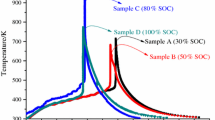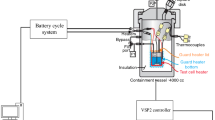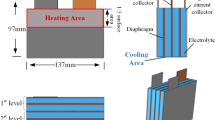Abstract
Thermal runaway (TR) is one of the main concerns in battery application due to their hazard level for the people and environment. In this work, the thermal runaway behaviors of lithium-ion batteries (LIBs) are investigated in ambient nitrogen (N2) concentration from 78 to 100%. Several parameters are measured to assess the fire hazards of LIBs, including battery surface temperature (Tsurf), ignition time (tig), total mass loss, heat release rate, and total heat release. The experimental results show that the risk of TR increases with the increase in state of charge. For different N2 concentrations, the addition of N2 will reduce oxygen (O2) concentration and weaken internal reactions, while excessive N2 will react with lithium-ion inside the LIBs. 82% N2 concentration shows the greatest inhibition effect on TR, where the values of battery surface temperature, total mass loss, heat release rate, and the total heat release reach the minimum ones.












Similar content being viewed by others
Abbreviations
- HRR:
-
Heat release rate, kW
- LIB:
-
Lithium-ion battery
- PCM:
-
Phase change material
- SOC:
-
State of charge
- THR:
-
Total heat release
- TR:
-
Thermal runaway
- t ig :
-
The ignition time, s
- T max :
-
The maximum temperature, °C
- t rup :
-
The rupture time, s
- T surf :
-
The surface temperature, °C
References
Zhang QS, Niu JH, Zhao ZH, Wang Q. Research on the effect of thermal runaway gas components and explosion limits of lithium-ion batteries under different charge states. J Energy Storage. 2022;45: 103759.
Baird AR, Archibald EJ, Marr KC, Ezekoye OA. Explosion hazards from lithium-ion battery vent gas. J Power Sources. 2020;446: 227257.
Zhao CP, Sun JH, Wang QS. Thermal runaway hazards investigation on 18650 lithium-ion battery using extended volume accelerating rate calorimeter. J Energy Storage. 2020;28: 101232.
Belov D, Yang M-H. Investigation of the kinetic mechanism in overcharge process for Li-ion battery. Solid State Ion. 2008;179:1816–21.
Guo GF, Long B, Cheng B, Zhou SQ, Xu P, Cao B. Three-dimensional thermal finite element modeling of lithium-ion battery in thermal abuse application. J Power Sources. 2010;195:2393–8.
Lamb J, Orendorff CJ. Evaluation of mechanical abuse techniques in lithium-ion batteries. J Power Sources. 2014;247:189–96.
Wang M, Le AV, Noelle DJ, Shi Y, Meng YS, Qiao Y. Internal-short-mitigating current collector for lithium-ion battery. J Power Sources. 2017;349:84–93.
Li WF, Rao S, Xiao Y, Gao ZH, Chen YP, Wang HW, Ouyang MG. Fire boundaries of lithium-ion cell eruption gases caused by thermal runaway. Science. 2021;24:102401.
Wang WH, He S, He TF, You TY, Parker T, Wang QS. Suppression behavior of water mist containing compound additives on lithium-ion batteries fire. Process Saf Environ. 2022;161:476–87.
Xie J, Li JP, Wang JH, Jiang JC. Fire protection design of a lithium-ion battery warehouse based on numerical simulation results. J Loss Prevent Proc. 2022;80: 104885.
Kise M, Yoshioka S, Hamano K, Kuriki H, Nishimura T, Urushibata H. Alternating current impedance behavior and overcharge tolerance of lithium-ion batteries using positive temperature coefficient cathodes. J Electrochem Soc. 2006;53:1732–6.
Partin P, Zeng S, Onnerud P, Song Y, Chamberlain R. Integrated current-interrupt device for lithium-ion cells. US. Pat No. US20080008928A1; 2008.
Yim H, Maeng S-Y. Lithium-ion secondary battery having safety vent responsive to temperature and pressure. US. Pat No. US7993778B2; 2011.
Liu KH, Xiao Y, Zhang H, Pang P, Shu CM. Inhibiting effects of carbonised and oxidised powders treated with ionic liquids on spontaneous combustion. Process Saf Environ. 2022;157:237–45.
Wu ZH, Wu Y, Tang Y, Jiang JC, Huang AC. Evaluation of composite flame-retardant electrolyte additives improvement on the safety performance of lithium-ion batteries. Process Saf Environ. 2023;169:285–92.
Wang QS, Jiang LH, Yu Y, Sun JH. Progress of enhancing the safety of lithium-ion battery from the electrolyte aspect. Nano Energy. 2019;55:93–114.
Zhang WC, Huang LS, Zhang ZB, Li XY, Ma RX, Ren YM, Wu WX. Non-uniform phase change material strategy for directional mitigation of battery thermal runaway propagation. Renew Energ. 2022;200:1338–51.
Dai XY, Kong DP, Du J, Zhang Y, Ping P. Investigation on effect of phase change material on the thermal runaway of lithium-ion battery and exploration of flame retardancy improvement. Process Saf Environ. 2022;159:232–42.
Yang XL, Duan YK, Feng XN, Chen TY, Xu CS, Rui XY, Ouyang MG, Lu LG, Han XB, Ren DS, Zhang ZP, Li C, Gao S. An Experimental study on preventing thermal runaway propagation in lithium-ion battery module using aerogel and liquid cooling plate together. Fire Technol. 2020;56(6):2527–602.
Niu HC, Chen CX, Liu YH, Li L, Li Z, Ji D, Huang XY. Mitigating thermal runaway propagation of NCM 811 prismatic batteries via hollow glass microspheres plates. Process Saf Environ. 2022;162:672–83.
Zhao JC, Lu S, Fu YY, Ma WT, Cheng Y, Zhang HP. Experimental study on thermal runaway behaviors of 18650 li-ion battery under enclosed and ventilated conditions. Fire Safety J. 2021;125: 103417.
Chen MY, Liu JH, He YP, Yuen R, Wang J. Study of the fire hazards of lithium-ion batteries at different pressures. Appl Therm Eng. 2017;125:1061–74.
Zhang YJ, Wang H, Li WF, Li C. Quantitative identification of emissions from abused prismatic Ni-rich lithium-ion batteries. eTransportation. 2019;2:100031.
Lyon RE, Walters RN. Energetics of lithium-ion battery failure. J Hazard Mater. 2016;318:164–72.
Weng JW, Ouyang DX, Liu YH, Chen MY, Li YP, Huang XY, Wang J. Alleviation on battery thermal runaway propagation: effects of oxygen level and dilution gas. J Power Sources. 2021;509: 230340.
García A, Monsalve-Serrano J, Sari RL, Martinez-Boggio S. Influence of environmental conditions in the battery thermal runaway process of different chemistries: thermodynamic and optical assessment. Int J Heat Mass Trans. 2022;184: 122381.
Said AO, Lee C, Stoliarov SI, Marshall AW. Comprehensive analysis of dynamics and hazards associated with cascading failure in 18650 lithium-ion cell arrays. Appl Energ. 2019;248:415–28.
Said AO, Lee C, Stoliarov SI. Experimental investigation of cascading failure in 18650 lithium-ion cell arrays: impact of cathode chemistry. J Power Sources. 2020;446: 227347.
Liu X, Stoliarov SI, Denlinger M, Masias A, Snyder K. Comprehensive calorimetry of the thermally-induced failure of a lithium-ion battery. J Power Sources. 2015;280:516–25.
Liu X, Wu ZB, Stoliarov SI, Denlinger M, Masias A, Snyder K. Heat release during thermally-induced failure of a lithium-ion battery: Impact of cathode composition. Fire Saf J. 2016;85:10–22.
Prathap C, Ray A, Ravi MR. Investigation of nitrogen dilution effects on the laminar burning velocity and flame stability of syngas fuel at atmospheric condition. Combust Flame. 2008;155:145–60.
Tao CF, Chen ZY, Ye QP, ·Li GY, Zhang·Y, Liu YQ. The study of thermal runaway characteristics of multiple lithium batteries under different immersion times. J Therm Anal Calorim. 2022; 147:11457–11466.
Huggett C. Estimation of rate of heat release by means of oxygen consumption measurements. Fire Mater. 1980;4:61–5.
Jia ZZ, Huang ZH, Zhai HZ, Qin P, Zhang Y, Li YW, Wang QS. Experimental investigation on thermal runaway propagation of 18,650 lithium-ion battery modules with two cathode materials at low pressure. Energy. 2022;251: 123925.
Jiang J, Dahn JR. ARC studies of the thermal stability of three different cathode materials: LiCoO2; Li[Ni0.1Co0.8Mn0.1]O2; and LiFePO4, in LiPF6 and LiBoB EC/DEC electrolytes. Electrochem Commun. 2004;6:39–43.
Tao CF, Li GY, Zhao JB, Chen G, Wang ZG, Qian YJ, Cheng XZ, Liu XP. The investigation of thermal runaway propagation of lithium-ion batteries under different vertical distances. J Therm Anal Calorim. 2020;142:1523–32.
Yang H, Bang H, Amine K, Prakash J. Investigations of the exothermic reactions of natural graphite anode for Li-Ion batteries during thermal runaway. J Electrochem Soc. 2005;152:A73–9.
Ma XY, Li J, Zhou HJ, Sun H. Continuous ammonia synthesis using Ru nanoparticles based on Li–N2 battery. Mater Today Energy. 2022;29: 101113.
Chen MY, Zhou DC, Chen X, Zhang WX, Liu JH, Yuen R, Wang J. Investigation on the thermal hazards of 18650 lithium-ion batteries by fire calorimeter. J Therm Anal Calorim. 2015;122:755–63.
Tao CF, Ye QP, Wang CM, Qian YJ, Wang CF, Zhou TT, Tang ZG. An experimental investigation on the burning behaviors of lithium ion batteries after different immersion times. J Clean Prod. 2020;242: 118539.
Chen MY, He YP, Chuang DZ, Richard Y, Wang J. Experimental study on the combustion characteristics of primary lithium batteries fire. Fire Technol. 2014;52:365–85.
Acknowledgements
The work was financially supported by the National Natural Science Foundation of China (Nos. 52274184 and 52074253), Natural Science Foundation of Anhui Province (No.1908085ME126), Fundamental Research Funds for the Central Universities (No. WK2320000053).
Author information
Authors and Affiliations
Corresponding authors
Additional information
Publisher's Note
Springer Nature remains neutral with regard to jurisdictional claims in published maps and institutional affiliations.
Rights and permissions
Springer Nature or its licensor (e.g. a society or other partner) holds exclusive rights to this article under a publishing agreement with the author(s) or other rightsholder(s); author self-archiving of the accepted manuscript version of this article is solely governed by the terms of such publishing agreement and applicable law.
About this article
Cite this article
Tao, C., Zhu, Y., Liu, Z. et al. The experimental investigation of thermal runaway characteristics of lithium battery under different nitrogen concentrations. J Therm Anal Calorim 148, 12097–12107 (2023). https://doi.org/10.1007/s10973-023-12534-1
Received:
Accepted:
Published:
Issue Date:
DOI: https://doi.org/10.1007/s10973-023-12534-1




